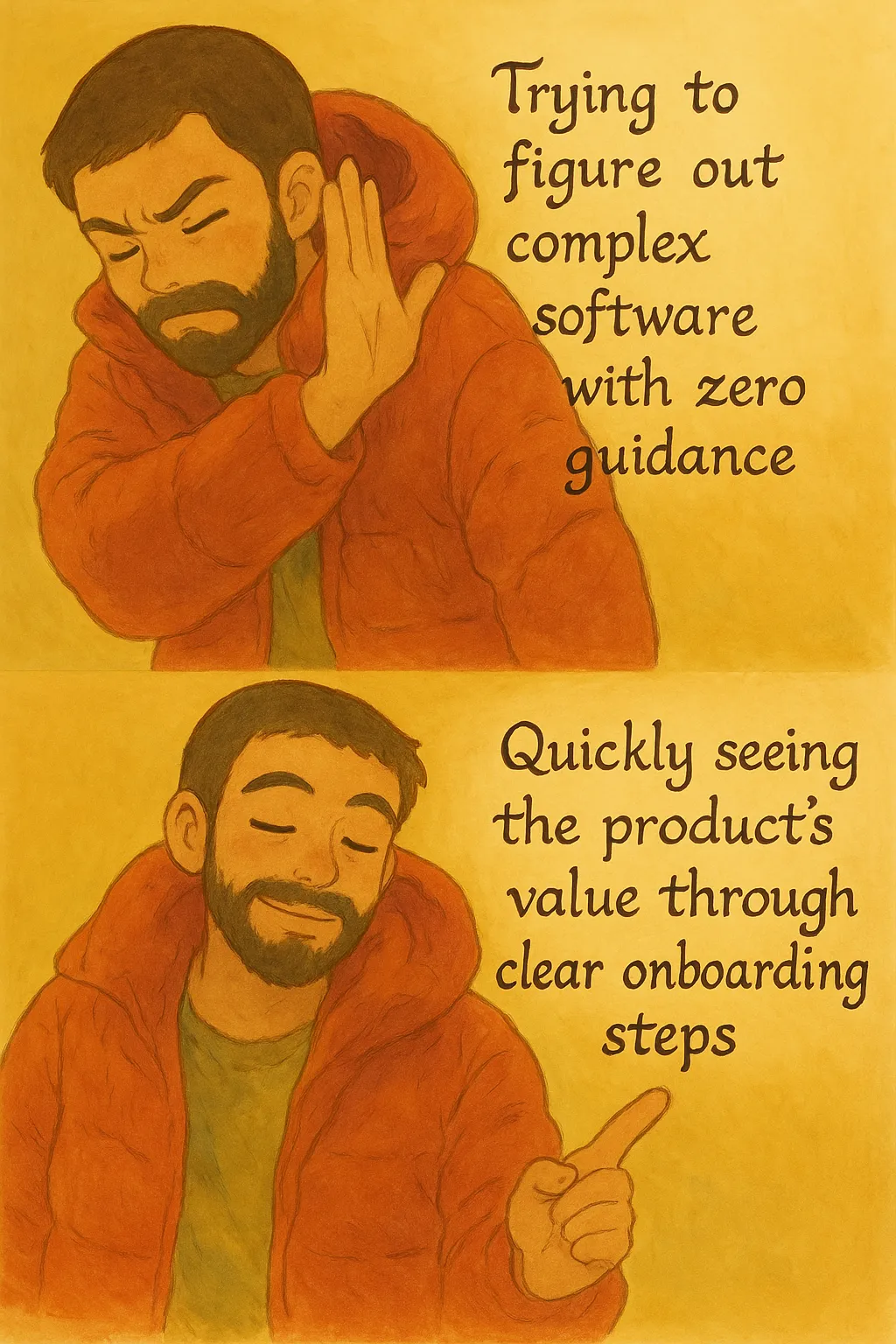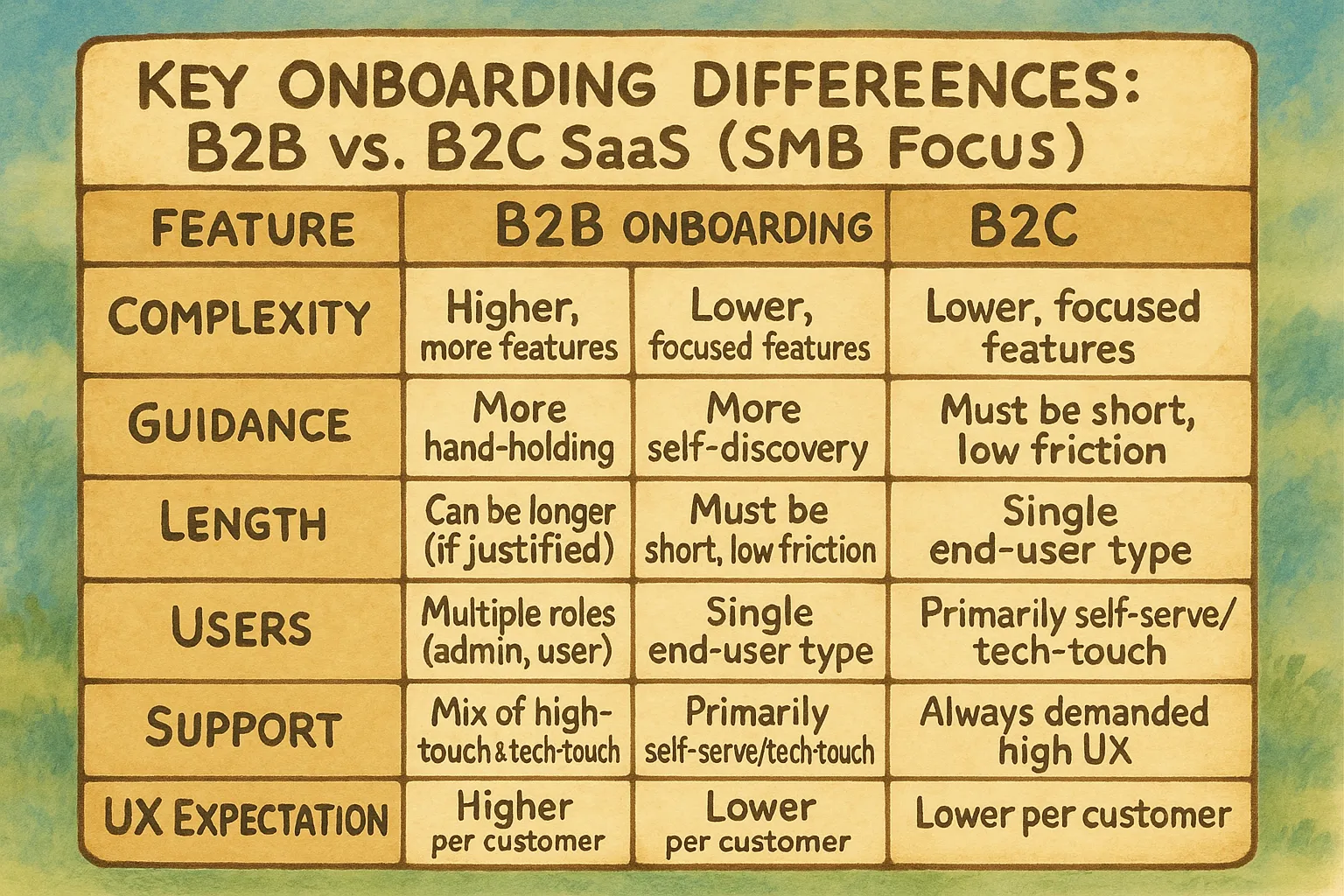Getting Started Right: Why User Onboarding is Key for SaaS Success (Part 1 of 3)

Imagine losing nearly three-quarters of your users every year. That was the reality for Salesforce at one point, facing an 8% monthly churn rate. They turned things around, doubling user growth within a year, largely by improving how they welcomed new users. This highlights a core truth for Software as a Service (SaaS) companies: getting the first user experience right matters immensely.
User onboarding is the process of guiding new users to understand and adopt a product, helping them see its value quickly. If users don’t get that initial benefit, they can easily leave and might never return – a customer lost due to poor onboarding can be “a customer gone for life.” Good onboarding drives success for SaaS companies, but the right approach differs between business-to-business (B2B) and business-to-consumer (B2C) products, especially for small and medium businesses (SMBs).
Why Good Onboarding is a Must-Have for SaaS
Onboarding isn’t just a welcome mat; it’s a foundational part of the user experience that directly affects your bottom line.
- The High Cost of Getting it Wrong: As Salesforce learned, poor onboarding leads to high churn and lost revenue. Users who stumble at the start are unlikely to stick around.
- Reaching the “Aha!” Moment Faster: Effective onboarding speeds up the user’s journey to the “Aha! moment”—that point where they first recognize the product’s real value. Customer onboarding aims to “remove friction between the customer and product to deliver value as quickly as possible.”
- A Driver for Growth: Successful onboarding means higher retention. Users who see value quickly are more likely to stay, upgrade their plans, and tell others about your product through word-of-mouth.
- Earning Loyalty in the Cloud Era: Today’s SaaS users have many choices. Since the rise of cloud software (the “after Benioff” era), companies must continuously earn customer loyalty through early and ongoing success.
- Impacting Long-Term Value: Good first impressions matter, but onboarding’s influence extends further. It directly affects long-term user engagement and the total value a customer brings over time (Lifetime Value or LTV).

B2B vs. B2C Onboarding: Understanding the Differences
While the goal of showing value is the same, how you onboard users can look quite different depending on whether your SaaS product serves businesses (B2B) or individual consumers (B2C), particularly within the SMB market.
-
Complexity and Guidance:
- B2B: Often involves more features and complexity, even for SMB tools. This means users face a steeper learning curve and usually need more guidance through in-app walkthroughs, tutorials, and support. Think of setting up a project management tool like Asana, which involves multiple steps like team info and project preferences.
- B2C: Typically has a narrower feature set and aims for simpler, self-explanatory design. Users might get minimal tutorial overlays and are expected to figure things out more independently. Netflix, for example, has a simple 3-step signup, after which users explore content without formal training.
-
Onboarding Length and Friction:
- B2C: The focus is usually on making onboarding extremely short and easy. Consumer users have little patience for long signups or tutorials.
- B2B: Users might accept a longer onboarding process if it’s clearly needed to achieve their business goals. Still, modern B2B products aim to reduce setup time. Product-led tools like Slack allow users to sign up and start using core features almost instantly with just an email. The balance is different: B2C avoids steps to prevent drop-offs, while B2B might include necessary setup (like data import or integrations) but must show the value of each step.
-
User Personas and Roles:
- B2C: Usually onboards a single type of end-user.
- B2B: Often deals with multiple user types within one customer account. An SMB might have an administrator who sets up the account and invites team members, who then need their own onboarding focused on basic usage. The content and guidance might differ—an admin sees setup checklists, while a team member sees feature tutorials. Designing for these distinct roles is necessary.
-
Personal Touch vs. Self-Serve:
- B2C: Relies almost entirely on self-serve onboarding within the product and automated communications (like emails). One-on-one help isn’t scalable.
- B2B: Especially for higher-value SMB customers, onboarding might involve customer success managers (CSMs) or support staff (“high-touch”). This could include kickoff calls or personalized training. Lower-priced B2B tools might use a more automated “tech-touch” or self-serve approach, similar to B2C. B2B onboarding often mixes product design with human support more frequently.
-
User Expectations and UX Maturity:
- Historically: B2C apps focused heavily on user experience, while B2B users sometimes tolerated less intuitive interfaces if the tool did its job.
- Today: SMB users expect B2B software to be as easy and pleasant to use as consumer apps. B2B onboarding is adopting cleaner UIs and interactive tutorials from the B2C playbook. Many modern B2B SaaS companies try to “delight users like a B2C app.” Both B2B and B2C onboarding must be user-friendly, but B2B may need extra guidance to handle its complexity.
-
Stakes of Churn:
- B2C: Losing one user might be expected in a high-volume market. The focus is often on acquiring new users to replace those who leave.
- B2B: Losing an SMB customer usually means a larger revenue hit. Companies often use annual contracts and have upsell potential, so they invest more in thorough onboarding to secure that relationship and prevent early churn. The cost of poor onboarding tends to be higher in B2B.

Laying the Groundwork
Understanding why onboarding is so important and how the needs differ between B2B and B2C contexts is the first step. A smooth start can significantly impact whether a user becomes a long-term, happy customer or quickly moves on.
With this foundation set, the next part of this series will look at how to build these effective onboarding experiences. We will cover specific user experience (UX) design patterns and the psychological principles that help make onboarding engaging and successful.
Read the next part of this series to learn how to design effective onboarding experiences.